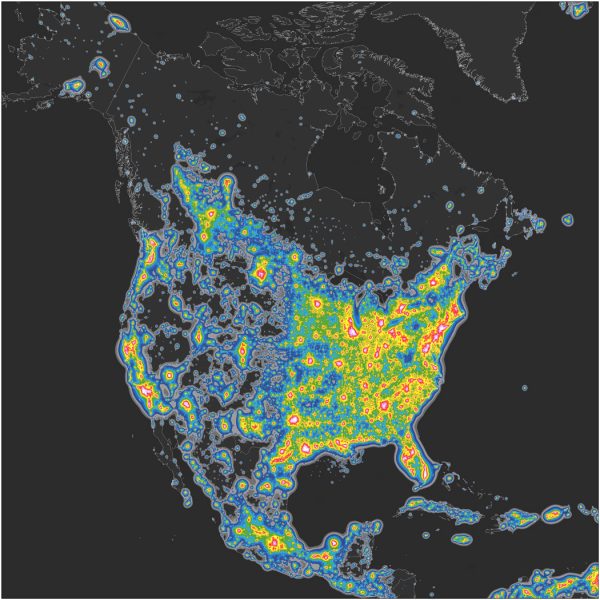Our night sky is shrinking. 99 percent of Americans live under light polluted skies, ones becoming approximately 10.4% brighter per year in North America (with a world average brightness increase of 9.6%). In a 2016 study, it was found that nearly 80% of North Americans were incapable of seeing the gorgeous Milky Way due to the amount of light pollution in their area, a number that has only risen in the 8 years since.
If light pollution continues to grow at its current rate, it is estimated that within the 18-year span of a childhood, star visibility will drop as much as 60%. And as light pollution rates soar, humanity only continues to drown out the stars faster and faster. In an attempt to preserve the ever-decreasing visible skyscape, the International Dark-Sky Association has designated dozens of safe havens in the U.S. for starry views–the Dark Sky Parks.
The International Dark-Sky Association began with the 1985 establishment of the Grasslands Observatory in Tucson, Arizona. The installation of unshielded lighting in the surrounding area led to severely decreased star visibility, a realization that prompted astronomer Dr. Tim Hunter to begin the IDA with the hope of preserving as much of America’s shrinking nighttime skies as possible.
In 2007, Utah’s Natural Bridges National Monument became the first International Dark Sky Park. It was designated as the location of the darkest sky observed in the United States, and significant efforts–like changing 80% of the lightbulbs within the park and starting a dark sky educational program–began for its preservation. In the years since the creation of the first International Dark Sky Park, over 130 other U.S. parks have been designated as such.
All parks designated as International Dark Sky Parks must have the Milky Way easily visible to the naked eye. Other requirements include the absence of artificial light in the area and restrictions on the presence of light domes. Dark Sky Parks who meet these requirements typically have a +6 on the Naked-Eye Limiting Magnitude scale. When a previously designated Dark Sky Park drops below a 5 on the NELM, it is considered an Endangered space.
Once an International Dark Sky Park is designated, plans for visibility preservation are immediately enacted; with the increasing light pollution rate, such quick action is unfortunately necessary. At the time of the park’s designation, 2/3rds of the installed outdoor lighting must comply with IDSA guidelines–and by the end of the following decade, that number must become 100%. Other management requirements that come with the designation include visitor education programs, in hopes of inspiring the public to take action to preserve their own skies outside of the park limits.
International Dark Sky Parks are spread all across the country, most commonly in western areas of the country with minimal light pollution like Utah, Colorado, New Mexico, and Arizona. Parks in the least populated areas tend to have the highest NELM score, as a general rule.

However, a cross-country trip is not necessary to enjoy the night sky. Cherry Springs State Park in Potter County, Pennsylvania, is one of the best places for stargazing on the eastern side of America. Designated by the ISDA as an International Dark Sky Park in 2008, this state park boasts 60-85 clear nights for stargazing a year. The park sits 700 feet above sea level in the midst of a 106,000 hectare undeveloped forest, creating a uniquely ideal situation for star observation. Cherry Springs is just a four-hour drive from North Allegheny Senior High School, making it a perfect place to start for anyone interested in seeing the clear night sky for themselves.
The designation and preservation of International Dark Sky Parks is essential to keeping the brilliant night sky visible to the unaided eye. As the sky gets brighter and brighter with light pollution each year, these parks are invaluable windows into the stars above. However, keeping the sky clear is not an effort that should only be taken within park boundaries. Light pollution is prevalent in the lives of every single American (99%), but it can be reduced significantly through the small efforts of every individual.
Here are some things you can do to keep the night sky dark:
- Use outdoor lighting only when absolutely necessary. Any amount of outdoor lighting removed reduces the amount of light emitted, keeping the sky a little bit darker.
- When outdoor lighting is necessary, keep the light facing downwards instead of pointed up at the sky. A thing as simple as reorienting a light can make a significant impact.
- Don’t let artificial light escape your house at night. Closing your blinds and curtains when it’s dark helps to reduce sky glow.
- Reduce the amount of blue light your outdoor lighting is emitting. Warmer color LEDs are less harmful when contributing to sky glow.
- Get involved in the fight against light pollution. The IDSA’s DarkSky program chapters are focused on educating communities about the risk our night skies are facing, and the efforts they can make to preserve a clear sky view for the generations to come.
- Educate others about the way they can make a difference. Informing your neighbors and families about how to minimize their contributions to light pollution can make a huge difference within your community and our country as a whole.



